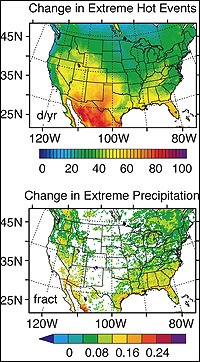Climate Model Predicts Extreme Changes for U.S.
The latest and most detailed climate model of the
continental U.S. predicts temperatures so extreme by the end of the century they
could substantially disrupt the country's economy and
infrastructure.

The latest and most detailed climate model of the continental U.S. predicts temperatures so extreme by the end of the century they could substantially disrupt the country's economy and infrastructure. The climate simulation, churned out by supercomputers at Purdue University, factors in dynamic environmental variables previously unaccounted for and analyzes them at a resolution twice as fine as previous models. The results indicate an increase in heat, heavier rainfalls and shorter winters, which could strain water resources for people and crops and cause a catastrophic loss of life and property, among other things.
"Climate change is going to be even more dramatic than we previously thought," says Noah Diffenbaugh, who reported his team's findings in the October 17 online edition of the Proceedings of the National Academy of Sciences. Until now, the fastest computers crunching climate data and using the most sophisticated computer codes have produced only a grainy image of the country's climate picture. For one thing, the codes--which incorporate data describing hundreds of natural variables such as ocean currents, cloud formation, vegetation cover, and the amount of greenhouse gases expected to exist in the atmosphere--have left out such factors as soil moisture, how much sun snow-cover reflects, and to what extent mountains thwart weather systems. What is more, previous models calculated the data by breaking the country into a grid of 50-kilometer squares, a resolution that can miss climatic nuances.
Diffenbaugh's model incorporates the additional natural variables and does so at a resolution of 25-kilometer grid squares. The smaller squares provide a higher resolution and a better picture of what is in store for the country by the end of the century. Assuming that human-generated greenhouse gases attain concentrations more than twice their current level, Diffenbaugh's model predicts several events: the desert Southwest will have more frequent and intense heat waves, combined with less precipitation during the summer; the Gulf Coast will grow hotter and experience heavier rainfalls in short time periods; the Northeast will suffer under longer, hotter summers; overall, the continental U.S. will undergo a warming trend that will reduce the length of winter.
The Purdue Report parallels the work from the Max Planck Institute I posted, last week. Although specific to the US, I didn’t think it would result in such expanded coverage.
To confirm the model's accuracy, Diffenbaugh ran it using weather data from between 1961 and 1985 and compared the prediction with what actually occurred. "The model performed admirably, which tells us we've got a good understanding of how to represent the physical world in terms of computer code," he comments.
Weather-related extremes such as floods, hurricanes and heat waves have lead to loss of lives and property. Hurricane Katrina alone claimed more than 1,000 lives and Congress has already set aside $62.5 billion for relief and rebuilding efforts. One heat wave during the summer of 1995 took 1,100 lives and the government spent $88 billion between 1988 and 1993 on three weather-related disasters (drought and flooding in the Midwest and Hurricane Andrew). Although the new results are alarming, they are not meant to create an alarmist view, Diffenbaugh explains. Rather they forecast a scenario that should be taken under serious consideration.
I expect that Know-Nothings will continue in place. Those interested in a more thorough examination of the science should visit here
Posted: Tue - October 18, 2005 at 09:54 AM